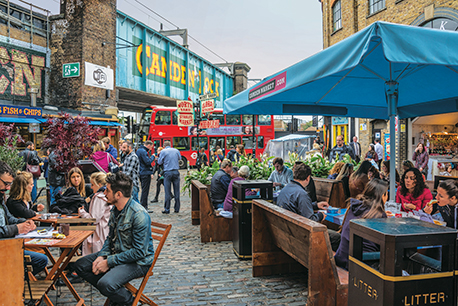London’s life-force, like many major cities, is fed by international cultures. It’s the flow of people from all around the world that keeps it vital. Nowhere is this more apparent than in the food available at London’s markets. This is where the world’s cultures come together to connect to a place that’s become home for them — where you can wash down a southern Indian masala dosa with a Bavarian beer. You can step into a food market and be assaulted by an intoxicating smell made up of a thousand different aromas. Britain is peculiar, as it doesn’t have an instantly identifiable cuisine in the vein of, say, Italy or France. Instead, London’s food markets are bastions of epicureanism, mini republics sprung up in defiance of the weather where people from around the world come to eat food from around the world. The challenge isn’t knowing where to start, it’s knowing when to stop.
SATURDAY
Borough Market
The tallest building in the U.K., The Shard, stands nearby with its head in the clouds, looking down on the mangrove root-like market as it weaves around the alleyways and arches around London Bridge. The market celebrated its 1,000th birthday in 2014. Things looked a bit different in the 11th century, when it was the portal to the only route across the river into the capital. Its location made it a prime market area, serving the Anglo-Saxons of the time, and today, foodies in skinny jeans and woollen beanies.
Threading through the crowds, tendrils of coffee aroma throw lassos around me and drags me towards Monmouth Coffee Company — ostensibly the best coffee in town. A queue of around 40 people snakes around the block, a testament to the alchemical powers of its brew. The wait proves worth it.
I spend the first hour or so wandering around, being blinded by super-shiny apples and tomatoes gleaming like jewels in Aladdin’s cave, and making awkward eye contact with an assortment of dead fish spread across ice. There are exotic mushrooms that look like sentient aliens and fresh, crusty bread twisted into wondrous shapes. I pick up a freshly squeezed carrot, apple and ginger juice from Total Organics that scourges away half of the hangover from last night’s ill-advised pub crawl.
Grazing my way through the cheese quarter, I opportunistically hoover up free samples of delicate buffalo mozzarella, creamy Brie and pungent Stilton. If the pound’s exchange rate is killing your wallet, it’s entirely possible to have a free meal just by taking advantage of these. Indeed, it’s virtually impossible to resist the morsels of olive tapenade, truffle honey, filled focaccia and flaky pastries. So, I don’t, and shamelessly gorge on my scavenged crumbs next to a gigantic, lurid orange wheel of Red Leicester.
Camden Market
Camden Market is a trial for anyone with a phobia of crowds. The majority are fellow tourists, moving glacially towards the food. The market is a sprawling network of connected stalls selling vintage clothes, crafts souvenirs and just about everything else, with food stalls located right next to the canal. I have ambitions of browsing racks of retro tweed, stacks of rare jazz vinyls and packs of knock-off Victorian postcards before getting food, but the crowds just won’t let me.
Wandering over to the street food section, I’m enveloped in a heady, steamy cocktail of scents. I manage to somehow walk past the sizzling burgers, giant pans of simmering paella, bubbling vats of curry and gently steaming dim sum to my chosen lunch: authentic Ethiopian. Torturously, the queue runs the length of the production line, so I witness every mesmerizing step that’s taken to produce my meal: spicy chickpeas in a rich, spicy gravy to be mopped up with the traditional spongy flatbread, injera. After, I grab some churros and hot chocolate sauce, and sit on the edge of the canal watching the barges navigating the locks.
Sunday
Brick Lane
Brick Lane is open on Sundays, when some other markets are closed. This spot in east London is bursting with fashionably heeled multitudes in search of bargains and bagels. The crowd has the usual throng of tourists, but they’re threaded through with locals whose steely, cynical glazes melt like everyone else’s when confronted with mounds of artisanal brownies. Food, clothing and bric-a-brac stalls line the main drag on Brick Lane proper, but the real gems are located in the courtyards and squares branching off it. I dip into the Sunday Upmarket at the Old Truman Brewery where the aroma emanating from Tenzin Rapten’s momos (traditional Tibetan dumplings) immediately seduces me. They’re delicately spiced, piping hot and melt in the mouth. The dumplings make a fine starter, but I’m after something more substantial, so I succumb to the siren call of the curry houses lining the streets. Brick Lane is famous for its curry; a visit is a rite of passage for anyone passing through London. Dozens of overzealous barkers are parked outside hollering about their USPs, so I decide on the only one that’s not bashing me over the head, the creatively named Famous Curry Bazaar.
I order a fiery chana masala that wouldn’t be out of place on the streets of New Delhi. For dessert I get cappuccinos from Nude Espresso and Oreo cupcakes from Nina’s Bakes, enjoyed while browsing the racks of vinyl at Rough Trade, London’s best independent music shop. Later I experience a pleasant sense of dislocation while watching the crowds flow through the graffiti-decorated streets, eating all kinds of food and speaking an array of languages.
Brixton Market / Pop Brixton
This neighborhood in southwest London (the birthplace of David Bowie) is a famously multicultural hub with an established West Indian population. Although the community is still intact, and authentic jerk cuisine can still be had, gentrification has let in a flood of upwardly mobile hipsters, manifested in trendy restaurants and bars.
I head to Brixton Market, where old and new Brixton weave together; West African wholesalers sit comfortably next to artisan bakeries. I have dim sum at Mama Lan, and could lean over to buy a toilet plunger from the Turkish general store next door. I also have some authentic Mexican tacos at Casa Morita, and looked over my shoulder to see the Madonna gazing beatifically at me from the window of a Dominican knick-knack store.
Around the corner is Pop Brixton, a village built of containers stacked upon each other like Lego blocks. The crowd is an eclectic mix of affluent families and cool young people with more tattoos than money. I’ve heard rumors that the best ramen in London is on offer here. Ming, the founder of Koi Ramen, beams through the steam as he hands over a bowl heaped full of the tastiest broth I’ve ever had.
More cool markets
Portobello Market
This market will be recognisable to most people from the film Notting Hill. The market is well-known for its antiques and I make my way through stalls selling piles of old watches and shoes with their tongues hanging out. My nose tells me I’ve reached the food section, where I immediately dip into a gloriously expansive pan of perfect paella.
Southbank Centre Food Market
There’s a relatively tiny open-air market outside but its location on the river makes it notable. It’s a truly special experience to grab a traditional German hot dog and walk along the banks of the Thames, in the shadow of the London Eye, checking out close-up views of Big Ben. It’s one of the most romantic places in London.
Maltby Street Market
A bit of a hidden gem, Maltby Street Market is tucked away among the railway arches in Bermondsey in south London. The focus here is on artisanal food and organic produce. An absolute must is traditional dhan (Taiwanese waffles). These light-as-air, bite-sized morsels have a delicate matcha tea flavor and are topped with your choice of custard, salted caramel or peanut brittle.
Post culled from worldwidedestinationguide





